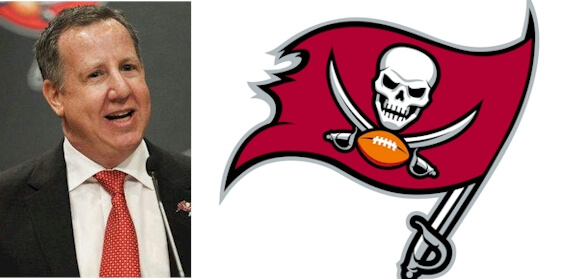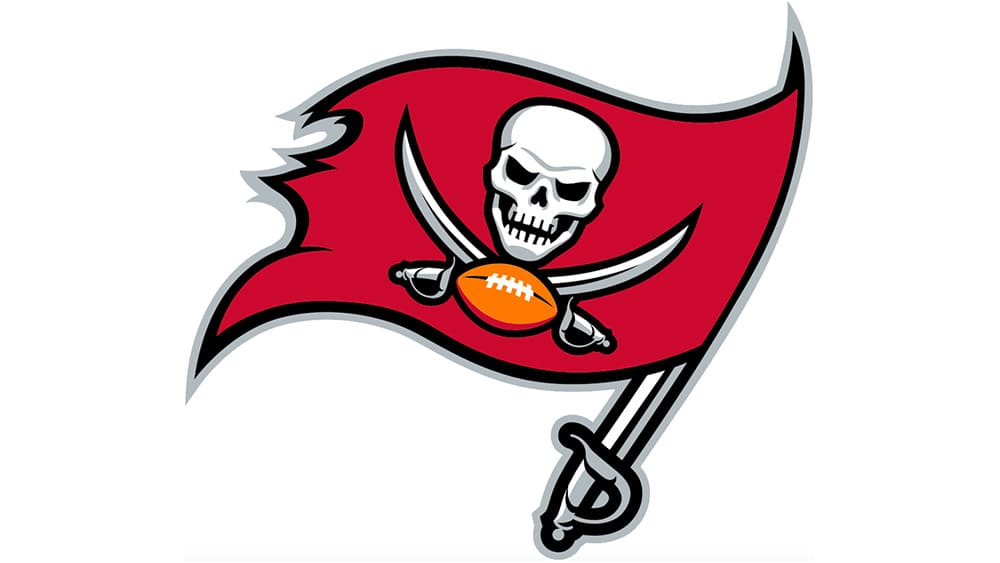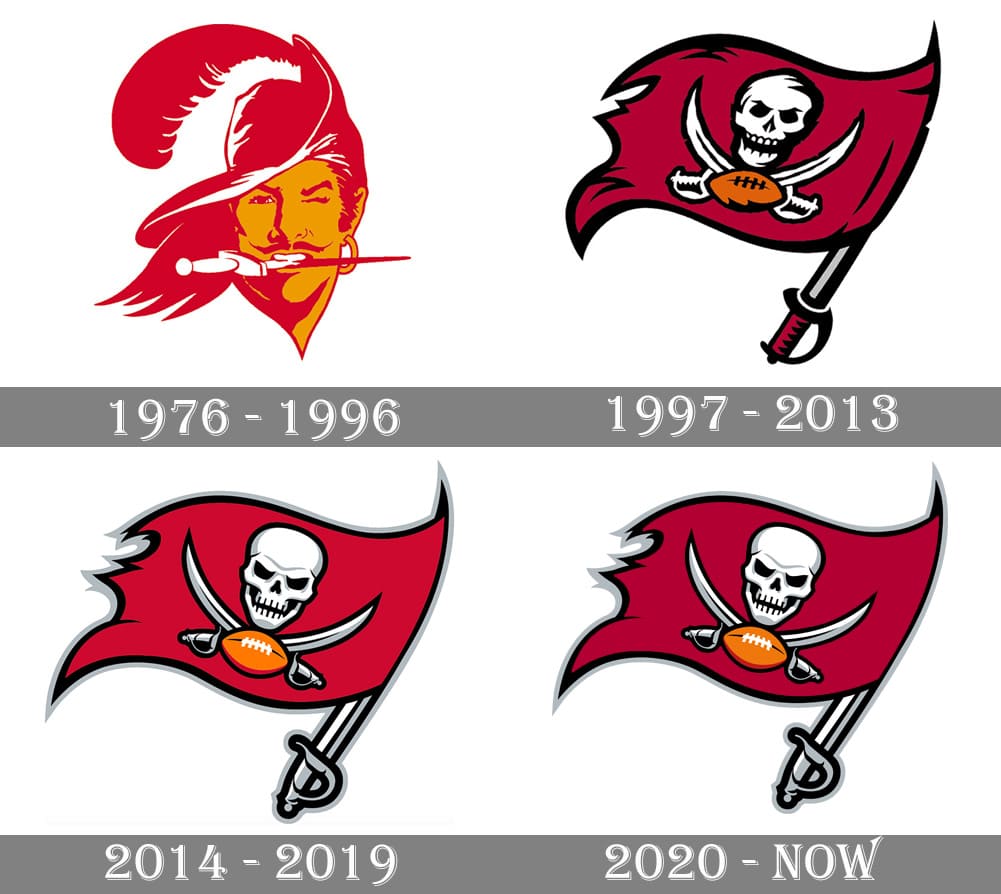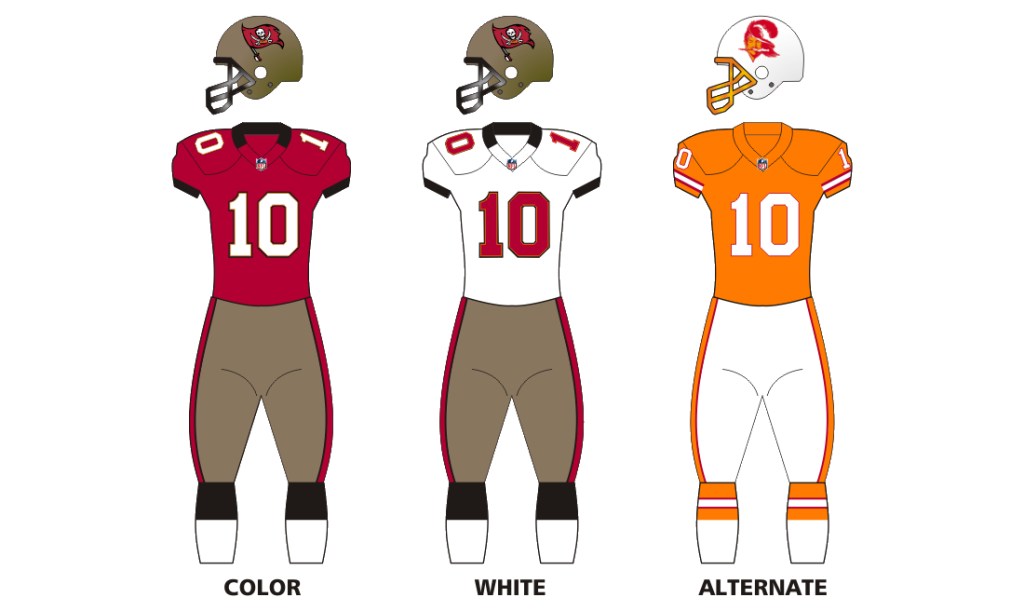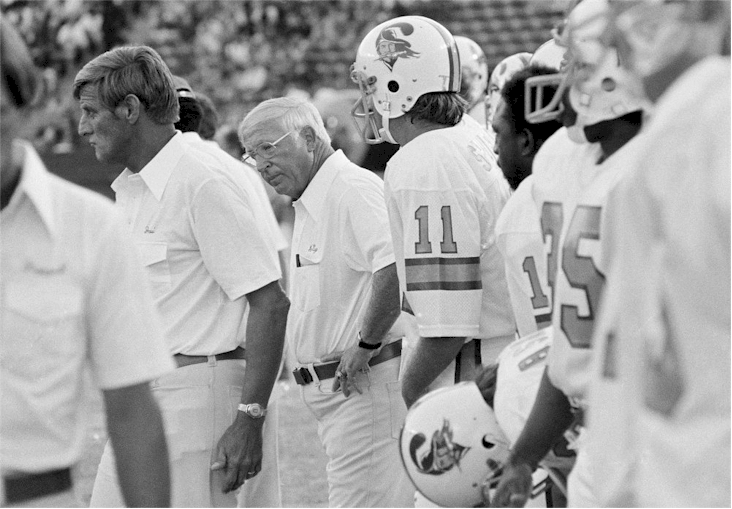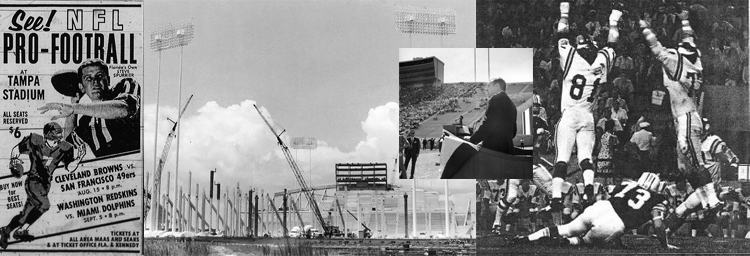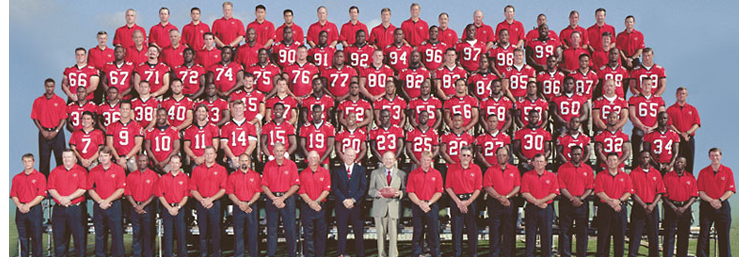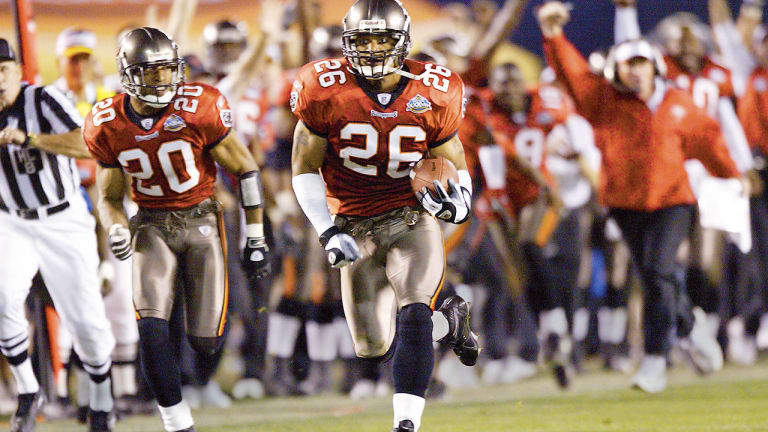Tampa Bay Buccaneers first appeared in the NFL in 1976 and brought with them one of the most unique logos at the time. Popularly known as the “Bucco Bruce,” the logo featured a pirate with a knife in his mouth. Although not overly intimidating, the logo gave the Bucs a great look that lasted through 1996.
After 1996, the Bucs changed its logo to a flag that has experienced slight modifications throughout the years. The logo’s color has remained red to symbolize passion and power throughout history.
The Bucs changed its uniforms in 2014, introducing a modernized logo on it, an orange tertiary color on the football, oversized helmet decals, among other changes. The same year experienced a redesign in Buccaneers logo to feature a more menacing skull placed over a football and crossed sabers.
Here, you’ll learn everything there is to know about the Tampa Bay Buccaneers logo, including its significance, who designed it, its history and evolution, and the history of the Tampa Bay Buccaneers.
Meaning of Tampa Bay Buccaneers Logo
Since its first introduction in 1976, the Buccaneers logo has featured a delightful color palette of fluorescent orange and red to signify Florida’s citrus industry and the warmth of its sunshine. Red also represents the team’s power, courage, and passion.
Who Designed the Tampa Bay Buccaneers Logo?
After its introduction into the NFL, the team commissioned cartoonist Lamar Sparkman to design their first logo. Lamar was working as a graphic designer for the Tampa Bay Buccaneers at the time. He designed a logo that featured a pirate named Bucco Bruce, who wore a wide-brimmed hat and clenched a knife in his mouth. The logo served the team for 20 years before being replaced by Jolly Roger in the logo.
History and Evolution of Tampa Bay Buccaneers Logo
Owned by the Glazer Family, Tampa Bay Buccaneers have boasted some of the most appealing logos over time.
The attractive color palettes on the team’s logo have existed since the first day. And although the composition of the emblem has changed over time, Buccaneers’ spirit of freedom and aesthetics were kept at their best.
Here is a timeline of how the logo has changed over the years.
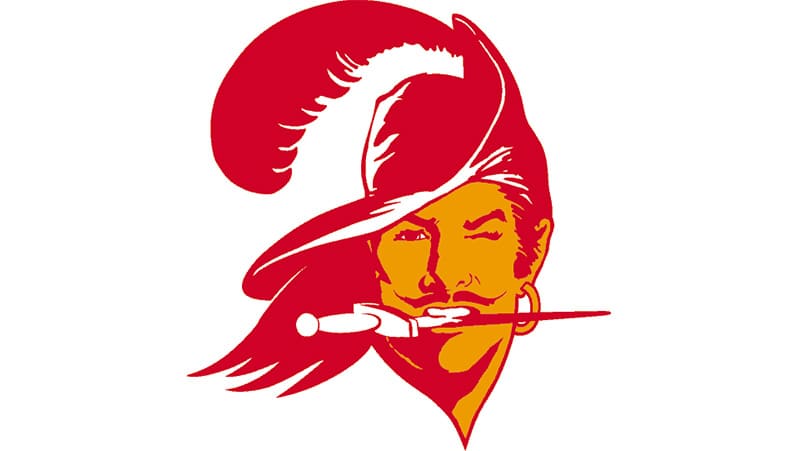
Tampa Bay Buccaneers logo from 1976 to 1996
The first-ever Tampa Bay Buccaneers logo was designed in 1976 by cartoonist Lamar Sparkman. The logo features a pirate whose face has some shades of red and yellow. The pirate holds a knife with a white handle and red blades with his teeth and has a large hoop earring. The pirate has a plumed slouch hat with a giant red feather at the top. The pirate appears to be winking, which helps combine the element of danger with playfulness.
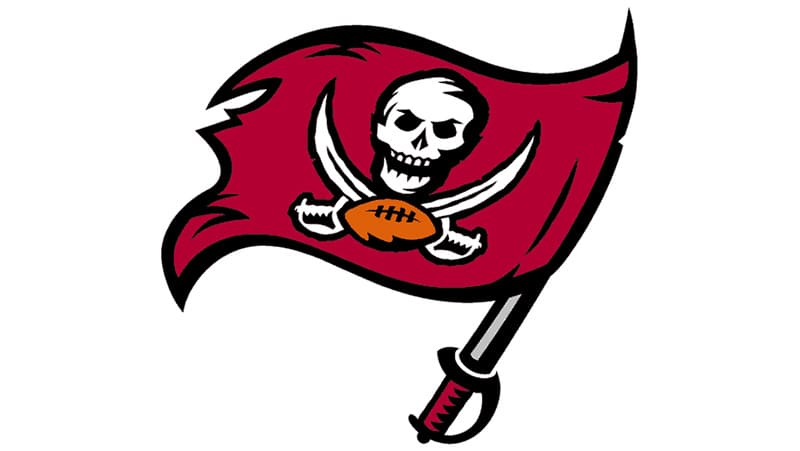
Tampa Bay Buccaneers logo from 1997 to 2013
In 1997, the Buccaneers were modified, seeing its most tremendous change in history. The pirate was replaced by a Buccaneer burgundy flag bearing a white Jolly Roger image in it. Also, the flag had a yellow football with black stitches placed under the skull and the crossed sabers. The flag’s handle features a sword gray and red. The end product was the first version of the logo that exists to date.
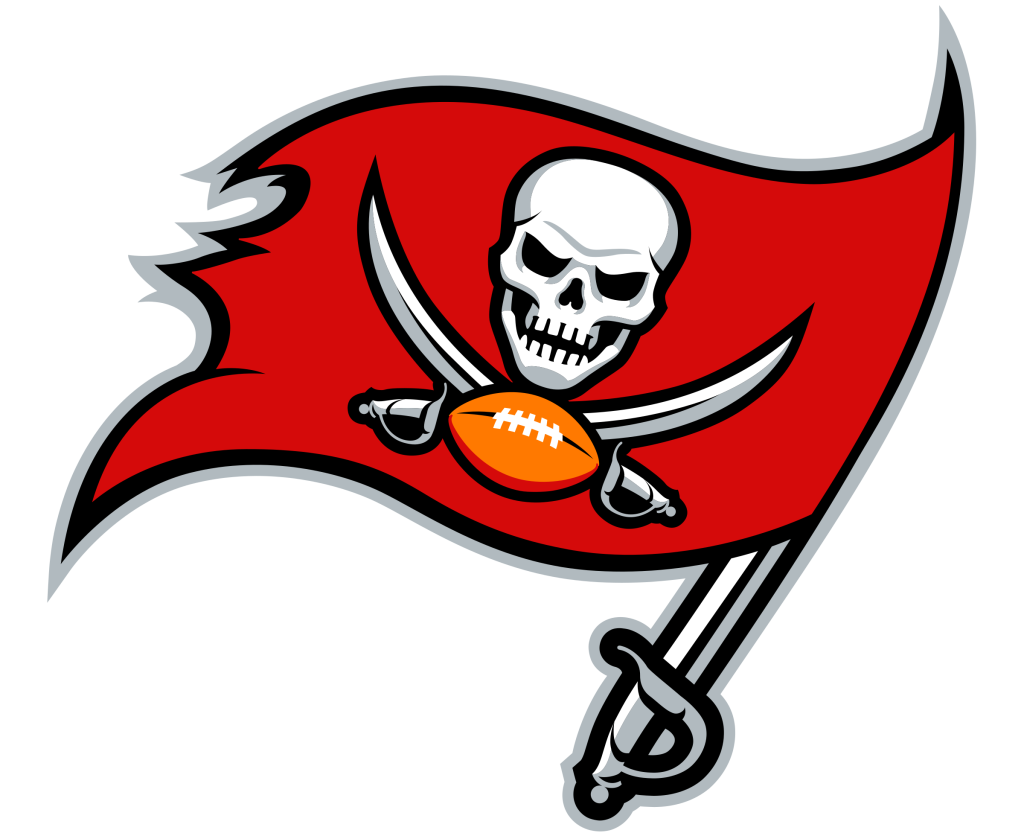
Tampa Bay Buccaneers logo from 2014 to 2019
2014 saw an update in the color palette of the emblem and its contours. The skull’s shape was made more smother, making it look scarier. The football’s stitches were changed from black to white, and a lighter shade of red replaced the flag’s burgundy color. The flag’s outlines were made thinner, and the red and gray saber’s handle was made silver-gray. The end product? A more professional- and elegant-looking logo.
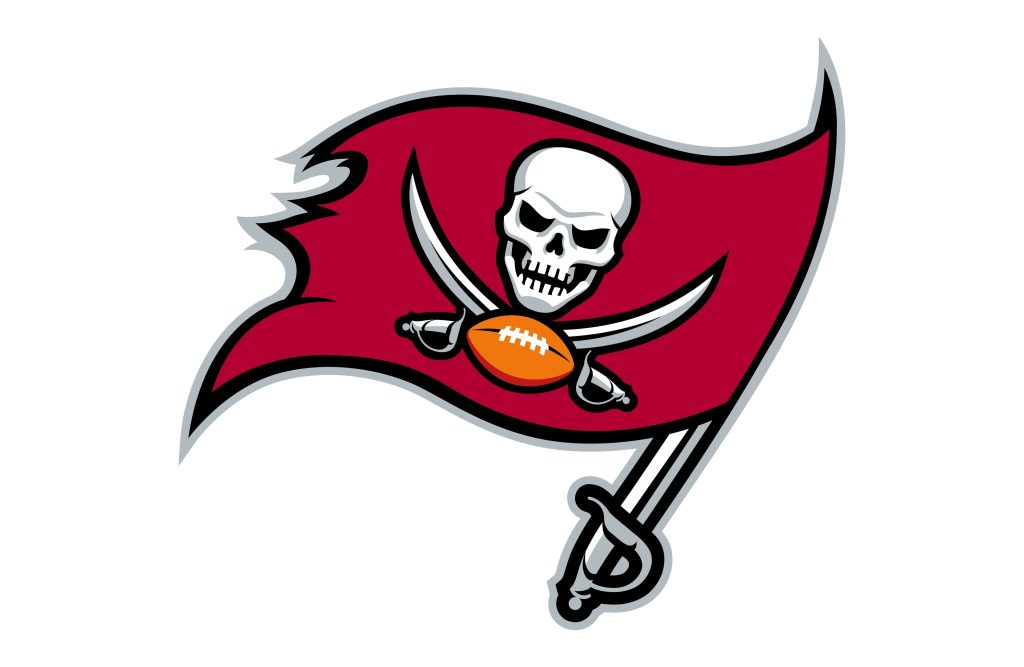
Tampa Bay Buccaneers logo from 2020 – Today
The 2020 redesign on the logo saw the burgundy color on the flag brought back, with the other elements remaining the same. This means that the yellow football with white stitches, the white Jolly Roger, and the silver-gray saber’s handle all remained.
Tampa Bay Buccaneers Logo Elements
Over the years, the Tampa Bay Buccaneers logo has seen several redesigns. Today’s emblem is entirely different from Lamar Sparkman’s first version, which featured a pirate clenching a dagger in his teeth. The logo, which appeared in April 1975, was replaced by a football-inspired Jolly Roger image in 1996.
The second version of the emblem was inspired by Calico Jack, a famous 18th-century pirate. That’s why there is a skull on a football placed between crossed swords. Over the years, Tampa Bay Buccaneers have updated their logo to represent them as a team. Today, the logo appears scarier but in a cartoonish manner.
A great logo is identified through its elements, including color, shape, sizes, typography, tone, etc. Let’s look at some of the current Tampa Bay Buccaneers logo elements.
Shape: The first Buccaneers logo was not a shape but rather the face of a pirate to symbolize toughness. Today, the logo is rectangular, signifying stability, solidity, and honesty.
Color: Throughout the Buccaneers logo, only a few colors have been dominant, including red (right red and burgundy), yellow, silver-gray, and white. Currently, the logo is burgundy, differing from the 2014’s by the shades of red only. The skull and the swords are white, with silver-gray shading to give them volume. Since 1996, football has been yellow. The logo has a black outline, except for the flag’s gray outline and handles. Generally, the color red/burgundy has been used to symbolize the team’s “courage and fortitude in battle.”
The Tampa Bay Buccaneers Current Uniform from 2020- Today
Typography: Typography is the font used in a logo design. There are no inscriptions on the Buccaneer logo. The designers didn’t use an existing font or develop a new one. Instead, they focused on the Jolly Roger image and chose colors carefully.
Also, several other logo elements have not been used in the Buccaneers logo, including sizes, tones, etc.
History of Tampa Bay Buccaneers
Tampa Bay Buccaneers is a professional NFL team representing the National Football Conference’s South Division. Owned by the Glazer Family, the Bucs have its headquarters in Tampa, Florida.
The Buccaneers joined the NFL in the same year as Seattle Seahawks and played its debut season in the West Division. The Bucs switched conferences and divisions with the Seattle Seahawks in the following year, playing in the NFC’s Central division.
Since its formation in 1976, the Bucs have won two Super Bowl championships and remain one of the only two NFL franchises to be undefeated in several Super Bowl appearances – along with the Baltimore Ravens.
However, things haven’t always been positive for this NFL team. During their first 20 years in the NFL, the Tampa Bay Buccaneers were regarded as perennial losers. They suffered 26 consecutive losses in their first several seasons and 14 straight losing seasons between 1983 and 1996.
Despite the early struggles, the Bucs have had a successful story. The team came out as the first post-merger team to win a division championship, play host to a conference title, and win a playoff match – all of which they achieved by 1979.
The Buccaneers won its first Super Bowl championship in 2002 and its second one in 2020. Today, the Bucs’ image has dramatically improved among NFL fans. However, the team has the least winning percentage record in the NFL at 39.7%.
Early history to the present
Here is a timeline of the Tampa Bay Buccaneers since its formation.
1976
The Tampa Bay Buccaneers was founded and suffered one of the worst defeats (14-0) in its history in its debut season.
1977
The Bucs joined their current conference after participating in the American Football Conference in 1976. The Bucs’ losing run continues in the NFC, with their first win coming in December 1977. Their 26-game consecutive defeats is still an NFL record in the Super Bowl’s history.
1979
The team shocks many NFL supporters after going on a 10-game winning streak. The Bucs wins qualify them for the postseason and make it to the conference title decider. However, the Buccaneers lost to the Los Angeles Rams in the title decider.
1981
The team reaches the playoff spot
1982
Tampa Bay Buccaneers make it to the playoff spot for a second consecutive year
1983 – 1996
The Buccaneers drop back down to the foot of the conference table with a record of 2-14. This year also marks the beginning of an embarrassing streak for the Bucs, which saw the team go for 14 consecutive seasons without a win. Tampa Bay Buccaneers would bring in some high-profile stars like Steve Young, who would flop throughout this period.
1993 – 1997
Tampa Bay Buccaneers fortune begins to turn around after Tony Dungy, the then coach, assembles one of the best defensive teams in the NFL. The team featured some of the best NFL players, including Derrick Brooks, John Lynch, Ronde Barber, Warren Sapp, etc.
1997 – 2001
Tampa Bay Buccaneers make four appearances in the postseason. The team’s poor offensive side lost their four playoffs, scoring less than 10 points in each game.
2002
Dungy is sacked, and Jon Gruden is hired as the new coach. In that season, the Bucs posted a 12-4 (the joint-best record in the league).
2003
During the Super Bowl XXXVII, the Buccaneers defeated the Oakland Raider 48-21 to claim their first title.
2004 – 2007
Tampa Bay Buccaneers fail to make it to the postseason but advance to the playoffs at the end of 2005 and 2007. However, the team suffers defeats at home in both matches.
2008
Coach Gruden is sacked after an embarrassing run of four winless games. The team also fires some more support staff to try and rebuild it from scratch.
2010
The Buccaneers win ten matches but fail to make it to the playoffs. This means that their 2008 effort to rebuild the team didn’t bear fruit. This year, the team hired Greg Schiano, a college football trainer, as the new coach. Greg presides over two losing seasons, including several embarrassing lows.
2013
Greg is fired after two disappointing seasons.
2016
The Buccaneers build their team around Jameis Winston, a youthful quarterback. The team posted their first winning record after six seasons.
2017 & 2018
Tampa Bay Buccaneers go back to their disappointing results, posting back-to-back defeats. The team lost records of 5-11 in both years.
2019
The Bucs hired Bruce Arians, the former Arizona Cardinals trainer, on a four-year contract. The team also makes great signings, including line backs Shaquil Barret and Deone Bucannon and offensive tackle Donovan Smith, and Breshad Perriman (a wide receiver).
Bruce’s first season is relatively good, with the team ending the season with a 7-9 record, which includes a run of four consecutive wins between weeks 12 and 15. Jameis Winston finishes the season with an outstanding record of 5,000+ passing yards, 33 touchdowns, and 30 interceptions.
2020
Despite Jameis Winston being their best player of 2019, the Bucs decide to phase him out. They signed the 6-times Super Bowl winner Tom Brady on a 2-year $50 million contract to replace Jameis. They also bring in retiree Rob Gronkowski. Tom Brady leads the Buccaneers to win an 11-5 record and earn them a playoff spot after 13 years. The Bucs defeated the Washington Football Team and New Orleans Saints before eliminating Green Bay Packers to get their first NFC championship in 18 years.
Tampa Bay Buccaneers qualify for Super Bowl LV, in which they defeat Kansas City Chiefs to clinch their second Super Bowl title. Tom Brady wins a record fifth NFL MVP.
Last Word on Tampa Bay Buccaneers History
The Buccaneers, or simply the Bucs, is an American football team based in Tampa, Florida. The Glazer Family owns the team after the death of Malcolm Irving Glazer, an American businessman, in 2014.
The team joined the NFL in 1976 alongside Seattle Seahawks, playing its debut season in the West Division. In the following year, the Bucs traded conferences with the Seattle Seahawks to become a part of the Central Division of the NFC. During the 2002 NFL realignment, Tampa Bay Buccaneers combined forces with three ex-NFC West sides to create the NFC South.

